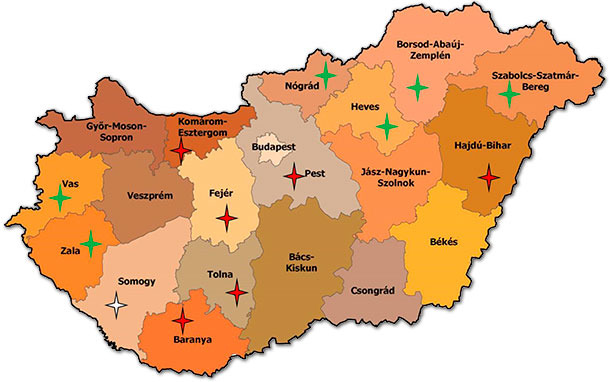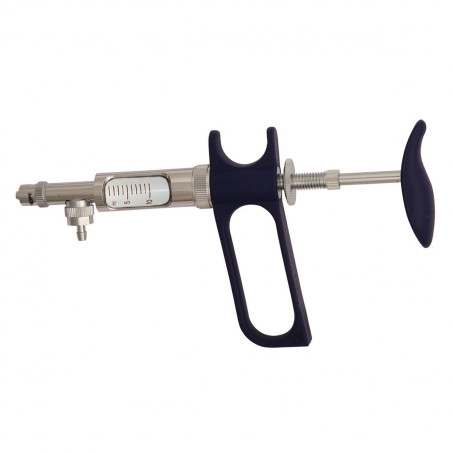Porcine reproductive and respiratory syndrome was first identified in Hungary in 1995. Until 2002 PRRS was a reportable disease, thus the prevalence of the infection was very low (2–3%). In 2002 the disease was removed from the list of reportable diseases, and after Hungary joined the EU, piglets of unknown health status started to enter the country from the Netherlands, Denmark, Germany, and following that, the prevalence started to rise quickly. The marked genetic variability of the recent strains supports the multiple introduction of the virus from various origin, and the long-term evolution of the local strains. Due to the negative impact of PRRS on profitability of pig production and the food chain safety sector, the disease eradication program has been implemented in Hungary.
During the process of planning of the eradication program the most important step was to get acquainted with the health status of the animals including the (i) registration and exact localization of the entire population especially of the infected animals, (ii) the distribution of the infected animals in the production sectors and (iii) the accurate charting of the ownership of the different herds.

The planning process of the PRRS eradication started in 2011, when yearly diagnostic screenings have been introduced to assess the prevalence of PRRS in large scale herds and backyard farms. In the years before 2014, 3.5% of the backyard farms, and 4.3% of the tested animals were positive (mainly breeding animals were sampled).
Without the implementing regulation the qualifying screenings of the large scale herds were not performed systemically until 2014. According to the latest examinations 14% of the 600 investigated large herds were found to be positive for PRRSV infection.
After the announcement of the National PRRS Eradication Ministerial Decree (3/2014 VM; 16 January 2014), but before the publication of the National Eradication Plan the committee conducted consultations with the major representatives of interests of the swine sector, with the members of the breeding companies, and integrations about the methods of the execution.
The Ministerial Decree provides the exact definition of the PRRSV infected pig. A pig is PRRSV infected if: (i) it shows clinical signs or post mortem lesions resembling PRRS, and the presence of the virus is shown by virological methods; (ii) the presence of the PRRSV, or its genome can be detected in the animal; (iii) it is seropositive for PRRS, non vaccinated and the presence of the antibodies is verified by different methods.
Every swine herd in Hungary has to get a qualification about its status. (Costs of the screening are paid by the owner of the herd, but it is free for backyard farms, and supported by the government for small and middle entrepreneurs.) Every pig in the breeding herd, including boars and a given percentage of the fatteners (95% confidence level, 5% prevalence) has to be tested serologically two times not sooner than 6 months. In a PRRS free herd this process has to be repeated annually. In an infected herd the owner has to make an eradication plan. The eradication plan has to be based on either herd closure or total depopulation/repopulation. Herd qualifications can only be performed by serological (ELISA, and in cases of unexpected positivity IPMA) made by the National Reference Laboratory (NRL). Monitoring of PRRS free herds can be performed by state laboratories that are chosen by the NRL.
Breeding animal can only be imported to Hungary from PRRS free herd where the confirming results are not older than 14 days. The transport must be followed by 60 days of quarantine where the pigs have to be tested within 48 hours after arrival, and 7 days prior the end of it. Fatteners imported to PRRS free areas or to areas undergoing PRRS eradication must originate from virus free herds.
According to the National Eradication Plan the most important results achieved by 31 May 2015 are:
- In every settlement of Hungary, every backyard farm that is known by the authorities, is free of PRRSV infection
- Every pig herd of the North Eastern region of Hungary (Nógrád, Heves, Borsod-Abaúj Zemplén counties) is free of PRRSV infection (Figure)
- The South Western region (Vas, Zala counties) is free of PRRSV infection
- During the PRRS eradication important experience was gained from several points of view. The analysis and implementation of these into further trainings for producers and veterinarians are not only related to PRRS eradication, it can be used in the whole pig sector as well.

Figure. Map of Hungary showing the counties of different PRRS status. Green asterisks indicate PRRS free counties, the white asterisk shows the county with a single positive herd, whereas red asterisk highlight counties under eradication. The unmarked counties are PRRS positive and they will be included in the eradication at a later stage.
As a single deviation from the National Eradication Plan the county of Somogy – due to a single large scale herd – did not fulfill the requirements of acquiring the PRRS-free status. Except the settlement of Somogyszob, every pig in the county of Somogy is free of PRRSV. By the end of 2017 every pig herd of this county is expected to be free of PRRS.
As declared in the next phase of the National Eradication Plan the November of 2014 counties of Baranya, Tolna, Fejér, Pest, Komárom-Esztergom, Hajdú-Bihar are defined as areas under eradication.
According to the present status and the experiences obtained during the previous one and a half year, Hungary will get free of PRRS by 2020.








